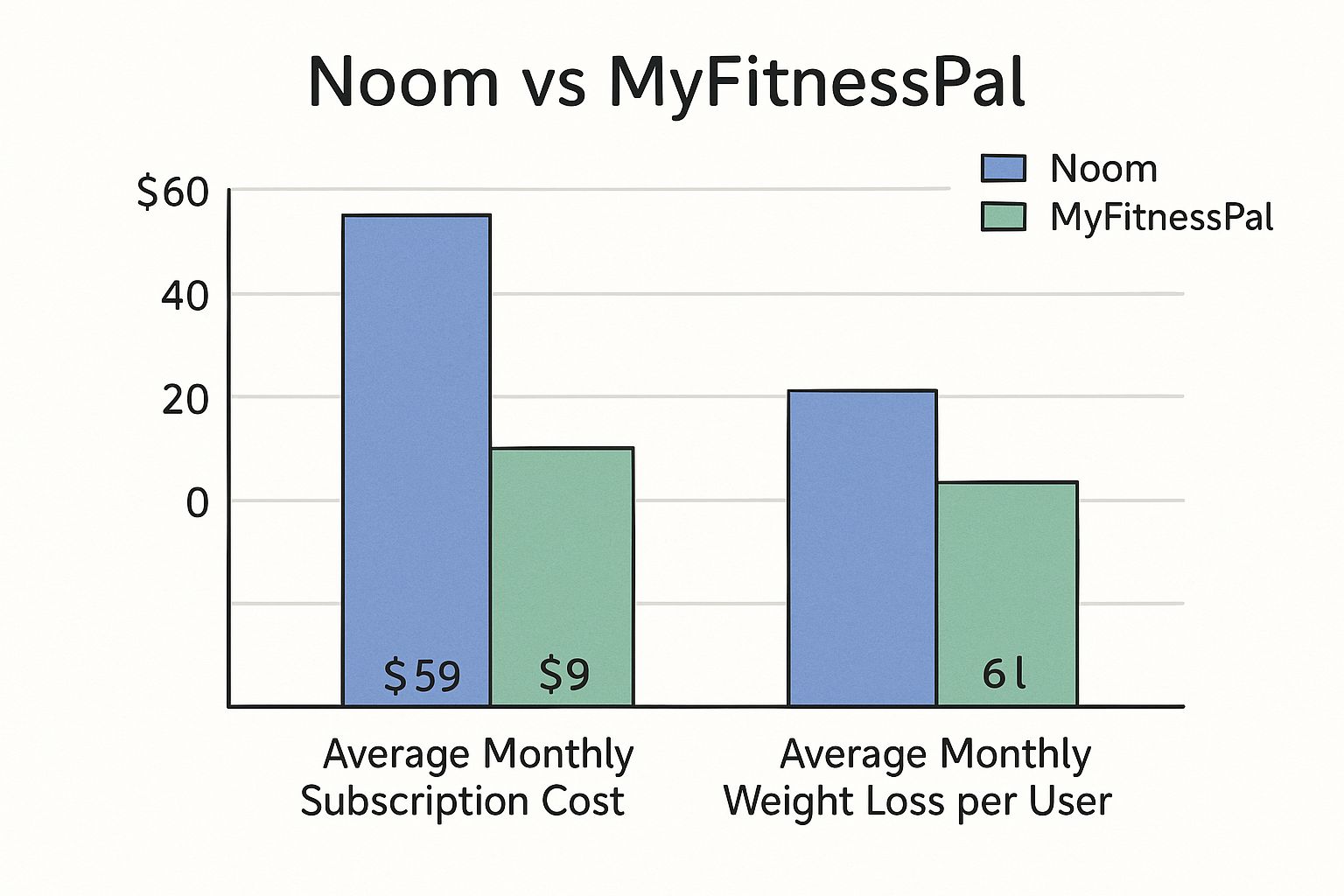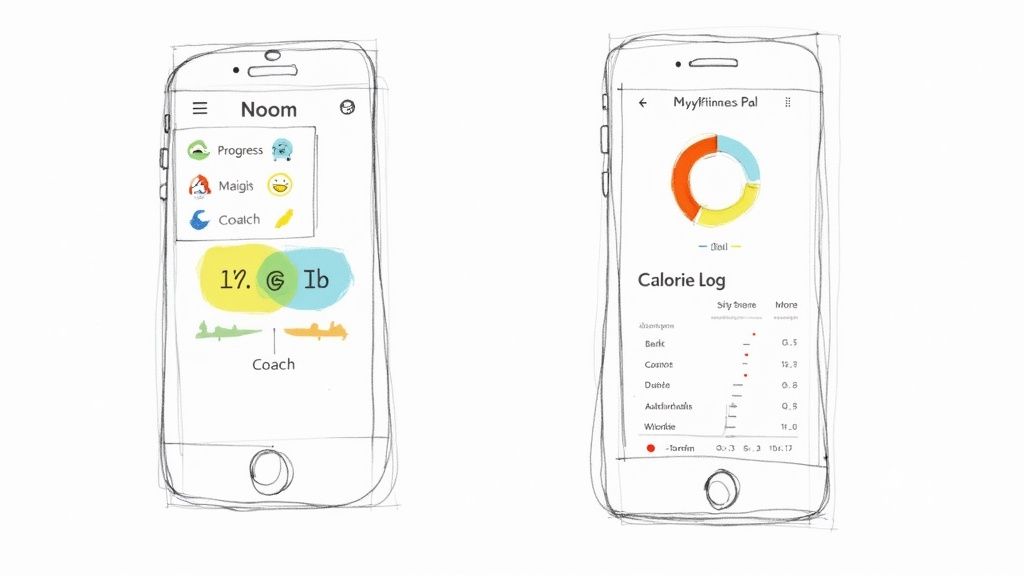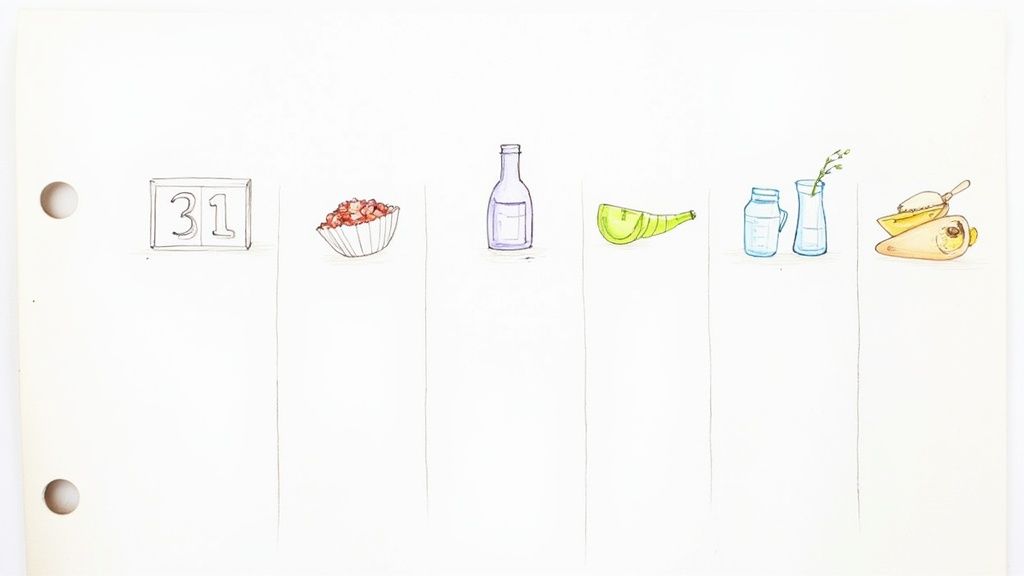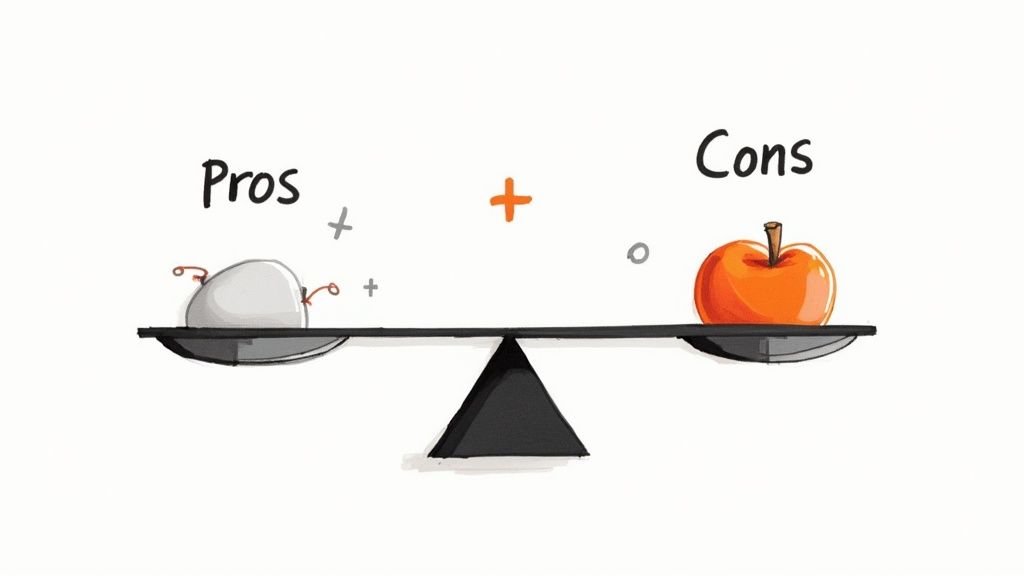Noom vs MyFitnessPal: Which Food Tracking App is Right For You?
Stuck choosing between Noom vs MyFitnessPal? This guide breaks down food logging, coaching, and costs to help you find the best app for your lifestyle.
Posted by
When you're picking between Noom and MyFitnessPal, it really comes down to one simple question: do you want a structured coach, or a super flexible food diary?
Think of Noom as your personal health coach. It’s built on psychology, designed to help you understand and change your eating habits for good. On the flip side, MyFitnessPal is a powerful food log. It’s a huge database perfect for tracking calories and macros, without locking you into a specific program.
Noom vs MyFitnessPal: The Core Differences
Choosing the right nutrition app isn’t just about comparing features; it’s about finding a vibe that clicks with your lifestyle. You’re picking a partner for your health journey, and while Noom and MyFitnessPal are both titans in this space, they take you down completely different paths.
Noom’s whole approach is rooted in behavioral psychology. It’s all about helping you understand the why behind your food choices to build sustainable habits. MyFitnessPal, however, is a straightforward and powerful calorie and macronutrient tracking tool. It gives you the data and lets you decide what to do with it.
This quick snapshot breaks down the key numbers—like average subscription cost and reported monthly weight loss—to give you a clear visual comparison right away.

As you can see, Noom comes with a higher price tag. But that cost is directly tied to its intensive, coaching-based model, which often translates to a higher average monthly weight loss for its users.
To make the choice even clearer, let’s look at their fundamental differences side-by-side.
A Quick Look at Noom vs MyFitnessPal
This table cuts right to the chase, showing how these two apps serve very different needs.
| Feature | Noom | MyFitnessPal |
|---|---|---|
| Primary Goal | To change your relationship with food using psychology and habit-building. | To track calories and macros with a massive, comprehensive food database. |
| Best For | People who want structured guidance and coaching to understand why they eat. | Individuals who love data, want flexibility, and prefer a straightforward logging experience. |
| Food Logging | Uses a simple color-coded system (green, yellow, red) to guide food choices. | Offers a massive, user-generated database with a very fast barcode scanner. |
| Support System | You get a dedicated personal coach and a peer support group. | Relies on a large community forum for peer-to-peer encouragement. |
| Pricing Model | A premium subscription-based program with a significant monthly investment. | A strong free version is available, with an optional, more affordable premium upgrade. |
Ultimately, your decision hinges on what you need most. Do you need the accountability and psychological tools of a coach, or the freedom and data-rich environment of a top-tier food diary?
A Side-By-Side Food Logging Test

So, how do these apps actually perform in the wild? Theory is one thing, but the true test is how they handle a regular day of eating. To find out, I put both Noom and MyFitnessPal through their paces with a simple, real-world menu.
Here’s the daily lineup I logged in each app:
- Morning Coffee: A standard latte with 2% milk from a local coffee shop.
- Homemade Lunch: A big salad with grilled chicken, mixed greens, cucumber, tomatoes, and a light vinaigrette.
- Restaurant Dinner: A classic margherita pizza from a popular chain restaurant.
This mix of a quick coffee run, a meal I made myself, and a standard restaurant dish is perfect for seeing where each app shines—and where it falls a bit short.
Logging Experience on MyFitnessPal
With MyFitnessPal, it's all about speed and data. Logging my morning latte was a breeze. A quick search for the local coffee shop pulled it up almost instantly. The barcode scanner is another massive time-saver for packaged goods; you just point, scan, and you're done.
The homemade salad took a bit more legwork. I had to enter each component individually—the chicken breast, the greens, the tomatoes, the dressing. While it took a minute, the app’s gigantic database had everything I needed, making it easy to build an accurate picture of my meal.
Key Takeaway: MyFitnessPal feels like a powerful, flexible logbook. Its massive user-driven food database is its greatest asset, perfect for anyone who wants granular detail and doesn't mind a little manual entry for homemade meals.
The sheer scale of its database can't be overstated. MyFitnessPal boasts around 3.7 million food items, one of the largest in the world. This is a game-changer when you're trying to track down a niche grocery item or a specific dish from a restaurant.
Logging Experience on Noom
Noom’s process, on the other hand, feels more like a guided lesson. When I logged the latte, the app found a generic equivalent and immediately categorized it as a "Yellow" food. This color-coded system is the heart of Noom's approach, gently steering you toward less calorie-dense choices.
Logging the homemade salad was structurally similar to MyFitnessPal—I added each ingredient one by one. The main difference is that Noom’s database is smaller and more curated. While I found what I needed, the options were more generic. The result? My salad was a sea of "Green" foods, which instantly reinforced that I'd made a good choice.
The pizza, predictably, was flagged as "Red." Noom doesn't shame you for it, but it does make you conscious of how these denser foods fit into your daily calorie budget. It’s less about the raw numbers and more about building mindfulness around your habits. For a deeper look at making this work for you, check out our guide on how to track calories.
In the end, both apps successfully logged my day, but they left me with entirely different takeaways. MyFitnessPal gave me the hard data, while Noom provided a layer of psychological feedback designed to shape my future decisions.
Coaching Guidance vs. Community Support: What's Your Style?

Just logging your meals is only half the battle. The real trick is staying motivated when life gets in the way, and this is where Noom and MyFitnessPal take completely different roads.
The choice really boils down to what keeps you going. Do you need a guide holding your hand, or do you draw energy from a crowd of people on the same journey?
Noom: The Guided, Psychology-Based Program
Noom’s entire philosophy is built on structured coaching and personal accountability. Think of it less like a simple food diary and more like an interactive course designed by behavioral psychologists to help you change your habits for good.
Here’s a look at how Noom’s coaching works:
- A Personal Coach: You're connected with a real human coach to help you set personalized goals, work through setbacks, and stay motivated via one-on-one messaging.
- Small Support Groups: You get placed into a small group of other users who started at the same time. It’s a dedicated space to share wins, vent about struggles, and learn from each other’s experiences.
- Daily Psychology Lessons: Each day brings new, bite-sized articles and quick quizzes. They’re designed to teach you the why behind your food choices, tackling everything from emotional eating to navigating social situations.
This structured, hands-on approach is fantastic for anyone who feels stuck and needs a clear curriculum to unlearn old patterns and build new, healthier ones.
MyFitnessPal: The Power of Peer Support
MyFitnessPal, on the other hand, puts its faith in the power of its massive, energetic user base. Instead of assigning you a coach, it opens the door to its legendary community forums, where millions of people connect every day.
Key Insight: The sheer scale of the MyFitnessPal community is its secret weapon. You can find a discussion thread on virtually any topic imaginable, from keto-friendly recipes and workout splits to motivation for getting back on track after a holiday.
This is a perfect fit for self-starters who don't necessarily want or need a coach checking in on them. If you're the type of person who gets inspired by seeing others’ progress and enjoys finding answers in a bustling, self-sufficient community, the forums are an invaluable resource.
So, when it comes to support, the difference is stark. Noom offers a defined, educational path with professional accountability. MyFitnessPal provides a vast, open-ended library of peer wisdom and a vibrant study group where you forge your own way.
Understanding the Cost and Daily Commitment
When you're trying to decide between Noom and MyFitnessPal, it's easy to get lost in the feature lists. But let's be real—the two things that will ultimately decide if you stick with an app are how much it costs and how much time it demands from you every day. These are the make-or-break factors that determine if a tool actually fits into your life.
The financial approaches here are night and day. MyFitnessPal built its reputation on an incredibly powerful free version, making it the go-to for anyone who just wants to start tracking calories and macros without opening their wallet. Noom, on the other hand, comes at it from a completely different angle. It's a premium coaching program from day one, asking for a real investment because it’s selling long-term habit change, not just a food log.
A Breakdown of Pricing Tiers
This difference in price really gets to the heart of what each app is trying to do. MyFitnessPal runs on a classic freemium model. You can use its fantastic free app forever, or upgrade to a premium subscription for around $10 per month to unlock more granular data.
Noom is positioned in a different league entirely, with plans that average out to about $24 per month when you commit to a typical four-month program. That price covers personalized coaching, daily lessons, and a whole psychological framework. For a more detailed look at how their costs compare, VNutritionAndWellness.com has a great breakdown.
Here’s the bottom line on cost:
- MyFitnessPal: Its free version is more than enough for most people. The paid tier is for the serious data-nerds who want to see detailed macro splits and get rid of ads.
- Noom: The subscription fee is the product. You're paying for the full structured experience—the daily lessons, the coach, the support group. There's no "free" option because the guidance is the entire point.
Daily Time Investment: What Each App Asks of You
Okay, let's talk about time. How much of your day are you willing to give to this? This is where your personality and needs will really point you in one direction.
Noom is intentionally designed for daily engagement. The program asks you to log meals, weigh in, and, most importantly, complete short psychology-based lessons every single day. This isn't just busywork; it's a deliberate structure meant to build the consistency you need to make new habits stick.
For someone who thrives on routine and needs that daily nudge to stay on track, Noom's check-ins are a godsend. It builds the accountability that so many of us are missing.
MyFitnessPal is the complete opposite. It’s as hands-off as you want it to be. You can be the person who meticulously logs every bite and sip, or you can just pop in once a day to track your dinner. There are no lessons to complete or mandatory check-ins. This makes it a perfect fit for self-motivated people or anyone who just wants a tool without the hand-holding.
Let's be real for a second. The biggest reason people quit tracking their food—whether on Noom or MyFitnessPal—is the sheer hassle of it all. You have to stop what you're doing, pull out your phone, and manually log every single thing you eat.
It’s the ultimate motivation killer. Life is busy. Who has the patience to type in every ingredient of their salad or hunt for the right barcode after a quick snack?
What if you could just skip all that? What if tracking was as simple as talking?
That's where the whole concept of food tracking gets a much-needed upgrade. Instead of opening an app and getting lost in a sea of options for "turkey sandwich," imagine just saying it out loud. "I had a turkey sandwich on whole wheat with lettuce and tomato." Done. Instantly logged.
Meet Effortless Voice Logging
This is exactly why we built Munchlog.ai. It's for people who want to be mindful of what they're eating but can't stand the tedious data entry of traditional apps. The goal here isn't about chasing clinical perfection; it's about building awareness in a way that actually fits into a normal, messy, busy life.
Think about all the times manual logging is a total pain:
- Trying to log your morning coffee while you're already running late.
- Struggling to remember every ingredient from last night's homemade dinner.
- Quickly grabbing a handful of almonds between meetings and forgetting to track it.
Voice logging turns these moments from a chore into a non-issue. You just speak what you ate, and the AI does the rest, giving you a solid estimate of your calories and macros.
The real power of voice tracking is how it removes friction. When logging takes just a few seconds, you're so much more likely to stick with it. That consistency is what builds a lasting habit of nutritional awareness, without all the stress.
This approach shifts the focus from obsessing over every calorie to simply staying in tune with your eating habits. If you're curious about how this works, you can learn more in our guide to finding an easy food tracking app that won't drive you crazy.
For anyone who finds manual logging a complete dealbreaker, a voice-first option really does change the entire game.
How to Choose The Right App For You
The Noom vs. MyFitnessPal debate can feel overwhelming, but it gets much simpler when you ask yourself one key question: What am I really trying to achieve?
Are you looking for a structured program to help you unlearn bad habits? Or do you just need a powerful, flexible tool to track your macros? Maybe you just want to be more mindful of what you're eating without all the tedious data entry. Your answer points directly to the right app for you.
This isn't about which app is objectively "better"—it's about which one fits your personality, your goals, and the amount of time you can realistically commit each day.
Which App Fits Your Lifestyle
Let's cut through the noise with a few common scenarios. Use this guide to find the perfect app based on your primary goals and tracking preferences.
| If Your Main Goal Is... | Your Best Fit Is... | Why It Works For You |
|---|---|---|
| To rebuild your relationship with food and you need structured guidance and daily lessons. | Noom | Its psychology-based program, personal coaching, and daily check-ins are built for long-term behavior change, not just counting calories. |
| To track macros and calories with maximum flexibility and you love diving into the data. | MyFitnessPal | Its massive food database, barcode scanner, and straightforward logging make it a powerful, data-rich tool for self-directed users. |
| To stay aware of your nutrition without the hassle of manual logging because you're busy. | Munchlog.ai | Its voice-first logging removes the biggest barrier to consistency—tedious data entry. It's perfect for casual, stress-free tracking. |
Think about what will keep you engaged long-term. Choosing the right tool from the start makes all the difference.
The best nutrition app is the one you’ll actually use consistently. If manual logging feels like a chore you’ll abandon in a week, then a structured program or a voice-first tool might be the key to your success.
Ultimately, it comes down to what you need. If you're looking for a guide, Noom is your coach. If you want a detailed diary, MyFitnessPal is your logbook. And if you just want to track your food without the friction, Munchlog.ai is your effortless assistant.
To see what other great options are out there, check out our complete guide on the best nutrition tracking apps.
Frequently Asked Questions

When you’re weighing Noom against MyFitnessPal, some very practical questions tend to pop up. Answering these is often the final step before you can confidently pick the app that truly fits your life.
Can I Actually Use MyFitnessPal for Free
Yes, you absolutely can. The free version of MyFitnessPal is surprisingly powerful, giving you everything you need for comprehensive calorie and macro tracking. It includes access to their enormous food database and the handy barcode scanner, making it a perfect fit for anyone who just wants a solid digital food log without spending a dime.
The Premium subscription adds more granular nutrient data and gets rid of the ads, but all the core features you need to get started are there for free.
Is Noom’s Coaching Really Worth the Cost
This really boils down to what you’re looking for. If you’ve been stuck in a cycle of yo-yo dieting and feel like you need a structured, psychology-based approach to finally change your habits, then Noom’s coaching can be a fantastic investment.
Those daily lessons combined with a personal coach create a level of accountability that you simply won't find in a free app. On the flip side, if you're already self-motivated and just need a tool to track your intake, the higher price tag probably isn't necessary.
The real value of Noom isn't just in logging what you eat, but in understanding the why behind your habits. It’s built for people who want to rebuild their relationship with food, not just count calories.
How Accurate Are the Food Databases
This is where the two apps really diverge. MyFitnessPal boasts a gigantic, crowdsourced database, which means its users are constantly adding new foods. While this gives you an incredible amount of variety, it also opens the door to occasional inaccuracies.
Noom takes a different approach with a smaller, professionally curated database. You might not find every single niche grocery item, but the nutritional information for the foods that are in there is generally much more reliable.
How Is Munchlog Different from Just Using Siri
It's a fair question! While you can certainly tell Siri to take a note, it doesn't have the ability to analyze the nutritional content of what you said.
Munchlog.ai is different because it uses specialized nutrition AI. It understands context—when you say "a turkey sandwich with avocado," it instantly breaks that down into estimated calories, protein, carbs, and fat. Think of it as a dedicated nutrition assistant, not just a generic voice recorder.
Tired of all the typing, scanning, and searching that comes with traditional food tracking? Discover a better way with Munchlog.ai. Just speak your meals, and let our AI do the heavy lifting. Try it now and see just how effortless nutritional awareness can be at https://munchlog.ai.